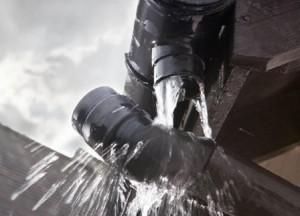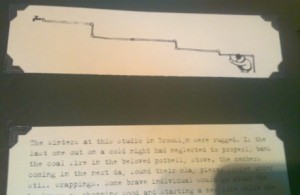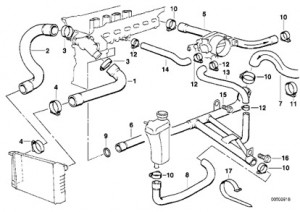The Leak
Danna Vajda

There is a leak. Some curators have assembled an enigmatic framing mechanism, procured a piece of real estate, possibly even funding, danced a rhythmic two-step of institutional cooperation, and presented us with a program that might transcend the space and time of the exhibition. The curators for this exhibition have, as a whole, created the characteristic glue between multiple organizational apparatus to make something happen in a public.
This event required an emblem, however, an object or image around which to organize the activities. Because the desired intention of this exhibition was to mine the gap between the artistic and the curatorial, the emblem was found in the archival binders from the DIY upstart days of an institutional art space. Just above a typewritten passage on “the rugged winters in the studio” was an image of a woman in a winter coat fixing a leak in the plumbing. From this image one can glean something that may have leaked out of curatorial practices emerging from experimental artist spaces and collectives, post-institutionalization. This early caricature serves the exhibition as a mechanism for thinking about the moment at which one person in a winter coat can serve as artist, curator, administrator, manager, and—most important for our purposes—maintenance worker, motivated by pleasure and struggle.
In maintenance terms, the exhibition has organized itself around a mechanics of fluids tending toward blockages and leaks within the curatorial complex. In addressing these leaks it is important to keep in mind that, “what is left un-interpreted in the economy of fluids [is] the resistances brought to bear upon solids.”[1] It is precisely this resistance to solids that the curators seek to locate.

semantics of incomplete beings
LEAK ONE: CARE FOR THE CHILD
According to Wikipedia, in Scotland the term curator is still used to mean the guardian of a child. In the curatorial endeavor of The Leak there is a desire to do precisely this: care for a clumsy child, not the artist necessarily, but the artwork. To create a space that would be safe for the exhibition of fragile objects and activities, so that they might develop into fully-grown phenomena.
However, amidst this coddling, at times the artist is fundamentally inseparable from the work. Rather than cultivating a thoughtful space for the artworks, one is found caring for the artists themselves, with congestive nanny rituals of booking flights, catering meals, and making sure there is no idle time un-entertained or at least unaccounted for.

LEAK FOUR: STRATEGIC AUTHOURSHIP
In the exhibition, the curators, while thoroughly professionalized and versed in the history of exhibition making, display an acute understanding of the ways in which professionalization has come about. Not fixating on the discourse of “artist as curator” and “curator as artist,” which they could embody through authorial excess and a brilliant catalogue essay, they instead attend to the experimental precipices as formed in artist-run spaces. Unhinged from a static position, they divide their time almost equally between organizational work and the theoretical work of defining their undefined position.
LEAK THREE: DISTRIBUTION OF TITLES AND WORK
In an attempt to dissolve the specifically authorial position of curators, some in this exhibition adopt a collaborative structure. This is an important experiment, as it unveils another key blockage in the system. As some of these anonymous organizational structures start receiving more attention, particular names in this group begin bubbling to the surface and garnering more value than the names of others. The prime issue within trying to create a flow for experimental curatorial flows in this system was alienation within an economy of the name.
“Conditions of inequality often go unremarked. The need to pursue other, less creative, precarious jobs to finance one’s own cultural production is something one puts up with.”[2] The economy of the name entails unnamed artistic activity, or unpaid production on the periphery of art institutions, in order to invigorate utopic notions of broad-based participation within the art world. What Lorey describes in relation to a self-exploitation to finance one’s own creative output, could be equally investigated in terms of a self-exploitation of creative input to participate in the knowledge economies. One suffers a liminal authorship, volunteering to make one’s name invisible, or tertiary or auxiliary, for the sake of proximity to valued names or to a larger production.
While these forms of authorial hierarchy were seemingly unavoidable even in the most earnest attempts to dissolve them, much of the work in this exhibition left the curatorial participants aware that as long as they allowed these forms of authorial grandeur and hierarchy to persist in an unquestioned manner, they would continue simply tending to leaks in a poorly constructed drainage, only to lessen the damage to a dank basement that more often than not stinks of contradictions.
THE MATERIALS FOR DRAINAGE
In a sense, this exhibition, as presented by the artist, does not represent curating. Instead, it reproduces the curatorial in the form of fetish—an object with special powers. Here the power represents the inverted potential of the burden to negotiate all of the above elements, in a new and creative way, for a model exhibition. In the process of assembling around these leakages it became clear that there was a total lack of anything to exhibit. The text is leaking, the administration is leaking, the structure is leaking, and one would hope that the curators of this exhibition will instead gush out, exhibiting the promoted exhibition, flooding the basement with a mess of new contradictions and ways of working together, so that they might have to get together not for an exhibition but simply to build a new drainage system.
Danna Vajda, is an artist and writer based in Brooklyn, New York. Recent exhibitions include both institutional spaces and provisional, less institutional spaces.
- While it is not particularly useful for the purposes of this text to take on the directly feminist debates with Freud, the discussion of fluids in Luce Irigiray, This Sex Which Is Not One (Chapter 6, “The ‘Mechanics’ of Fluids”) ascribes an organic social quality to the way this text tries to understand curating and its gravitation toward becoming “solid” and fixed modalities as well as its equal founding within fluid experimental formations of social time and space. “Certainly these ‘theoretical’ fluids have enabled the technical—also mathematical form of analysis to progress, while losing a certain relationship to the reality of bodies in the process.” Page 109. return to text
- Isabell Lorey.“Virtuosos of Freedom: On the Implosion of Political Virtuosity and Productive Labour.” Translated by Mary O’Neill. Critique of Creativity: Precarity, Subjectivity and Resistance in the ‘Creative Industries’. Gerald Raunig, Gene Ray and Ulf Wuggenig, eds. P. 79. 2011 return to text
-- Download The Leak as PDF --